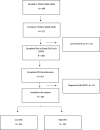Diabetes Distress in Young Adults With Youth-Onset Type 2 Diabetes: TODAY2 Study Results
- PMID: 35015056
- PMCID: PMC8918198
- DOI: 10.2337/dc21-1689
Diabetes Distress in Young Adults With Youth-Onset Type 2 Diabetes: TODAY2 Study Results
Abstract
Objective: To assess the prevalence of high diabetes distress and associated factors in the Treatment Options for Type 2 Diabetes in Adolescents and Youth (TODAY2) study cohort of young adults with youth-onset type 2 diabetes.
Research design and methods: Participants completed the Diabetes Distress Scale (DDS) at end-of-study visits. Factors examined for association with high distress were demographic (sex, race/ethnicity, age, education, income), medical (HbA1c, BMI, complications), psychological (depressive and anxiety symptoms), and social (number in household, offspring, health care coverage, established with diabetes care provider). Univariate logistic regression identified factors associated with high distress that were controlled for in multivariate logistic regressions.
Results: Of 438 participants, 66% were female (mean age 26.8 years, 18% non-Hispanic White, 37% non-Hispanic Black, 38% Hispanic). High distress (DDS ≥2) was reported by 105 (24%) participants. Subscales identified 40% with high regimen distress and 29.7% with high emotional burden. A greater percentage of those with high distress were female (P = 0.002), diagnosed with hypertension (P = 0.037) and retinopathy (P = 0.005), treated with insulin, had higher HbA1c, and had moderate to severe depressive and anxiety symptoms (all P < 0.001). In multivariate analyses, female sex (P < 0.001), HbA1c (P < 0.001), anxiety symptoms (P = 0.036), and lack of health care coverage (P = 0.019) were associated with high distress, after controlling for potential confounders. Moderate to severe depressive symptoms were associated with high regimen distress (P = 0.018) and emotional burden (P < 0.001); insulin treatment was associated with high emotional burden (P = 0.027).
Conclusions: Future research should identify modifiable factors associated with high diabetes distress in young adults with youth-onset type 2 diabetes that may inform distress interventions with this medically vulnerable group.
Trial registration: ClinicalTrials.gov NCT00081328 NCT01364350 NCT02310724.
© 2022 by the American Diabetes Association.
Figures
References
-
- Polonsky WH, Anderson BJ, Lohrer PA, et al. . Assessment of diabetes-related distress. Diabetes Care 1995;18:754–760 - PubMed
-
- Skinner TC, Joensen L, Parkin T. Twenty-five years of diabetes distress research. Diabet Med 2020;37:393–400 - PubMed
-
- Perrin NE, Davies MJ, Robertson N, Snoek FJ, Khunti K. The prevalence of diabetes-specific emotional distress in people with type 2 diabetes: a systematic review and meta-analysis. Diabet Med 2017;34:1508–1520 - PubMed


